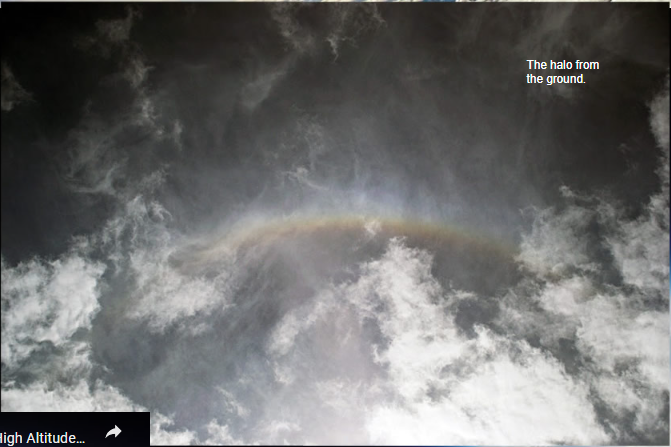Ballon & Ground Halos Simultaneously - OPOD
Ballon & Ground Halos Simultaneously - OPOD: Capturing Atmospheric Phenomena from New Heights
Have you ever wondered what it would be like to witness atmospheric optics phenomena from high above the Earth's surface? Thanks to advancements in technology and the adventurous spirit of a team from Bolton School in England, we now have the opportunity to experience the beauty of halos from both the ground and the sky simultaneously.
In a remarkable feat, the team launched a high altitude helium balloon equipped with a high definition 4K GoPro camera from Elseworth near Cambridge, England. As the balloon ascended, it captured breathtaking images of atmospheric halos at an impressive altitude of 108,000 feet (20.5 miles) before bursting and landing near Thetford in Norfolk.
The exact height at which the halos were imaged from the balloon is difficult to determine precisely. However, the appearance of the cumulus clouds far below provides a visual reference point. On the ground, the team also captured images of the same halos, allowing for a fascinating comparison between the perspectives from different altitudes.
Alec Jones and the Bolton School Team's stunning photograph showcases a high altitude halo, featuring a 22° halo and an upper tangent arc. The visibility of these atmospheric phenomena is somewhat impeded by the low cumulus clouds present at ground level. This observation emphasizes the flatness of Cambridgeshire and the Fens region.
To provide an immersive experience, the team has shared a captivating flight video of the high altitude balloon launch. Watching this footage allows us to feel as if we are soaring through the sky, witnessing the halo phenomena unfold before our eyes. Strap in and prepare for an exhilarating journey!
While we admire the awe-inspiring images and videos captured by the team, it is essential to understand the science behind these atmospheric optics phenomena. Halos occur when light interacts with ice crystals suspended in the atmosphere. The specific shape and orientation of these ice crystals determine the type and appearance of the halo.
The 22° halo, a circular halo centered on the sun or moon, is one of the most common types of halos observed. It forms when light enters through one side of the ice crystal and exits through another, bending at an angle of approximately 22 degrees. The upper tangent arc, seen in the photograph, is a curved arc that appears above the 22° halo. It forms when light passes through the side face of a hexagonal ice crystal and exits through a top face.
By capturing these halos from both high above and at ground level, the team has provided a unique opportunity to study and compare their characteristics. This multi-perspective approach allows researchers and enthusiasts to gain a deeper understanding of how atmospheric conditions and crystal formations influence the appearance of halos.
The endeavor undertaken by Alec Jones and the Bolton School Team showcases the power of curiosity, innovation, and teamwork in unraveling the mysteries of our atmosphere. Through their efforts, we are reminded of the vast beauty and complexity that surrounds us, even in the seemingly ordinary phenomena of halos.
As technology continues to advance and more daring explorations take place, we can look forward to further insights into atmospheric optics. The ability to capture simultaneous images of halos from different altitudes opens up new possibilities for research and visual storytelling. It invites us to appreciate the wonders of our atmosphere from all perspectives, both on the ground and high above. So, keep your eyes on the sky and be ready to witness the next breathtaking discovery in atmospheric optics.

High and Low Altitude Halo ~ Alec Jones (Bolton Halo Triangle) and the Bolton School Team captured this high altitude halo. Near simultanoeusly (lower right) they imaged the same from the ground. All images ©Alec Jones & Bolton School Team, shown with permission
How?
The team launched a high altitude helium balloon from Elseworth near Cambridge, England.
The balloon carried a high definition 4K GoPro camera and reached 108,000 feet (20.5 miles) before bursting. It landed near Thetford in nearby Norfolk.
The height of the balloon when the halo was imaged was not precisely known but can be judged from the appearance of the plentiful cumulus way below.
Alec's height for the image at right of the 22° halo and upper tangent arc - somewhat impeded by the same low cumulus - was near to zero. Cambrideshire and the Fens are flat!.
Right below is the flight video. Fasten your seat belt tightly!

The halo from the ground.
<iframe width="560" height="315" src="https://www.youtube.com/embed/NpPuESSbhAc" title="Bolton School in Space - Full Video of High Altitude Balloon Launch" frameborder="0" allow="accelerometer; autoplay; clipboard-write; encrypted-media; gyroscope; picture-in-picture; web-share" allowfullscreen></iframe>
Note: this article has been automatically converted from the old site and may not appear as intended. You can find the original article here.
Reference Atmospheric Optics
If you use any of the definitions, information, or data presented on Atmospheric Optics, please copy the link or reference below to properly credit us as the reference source. Thank you!
-
<a href="https://atoptics.co.uk/blog/ballon-ground-halos-simultaneously-opod/">Ballon & Ground Halos Simultaneously - OPOD</a>
-
"Ballon & Ground Halos Simultaneously - OPOD". Atmospheric Optics. Accessed on November 26, 2024. https://atoptics.co.uk/blog/ballon-ground-halos-simultaneously-opod/.
-
"Ballon & Ground Halos Simultaneously - OPOD". Atmospheric Optics, https://atoptics.co.uk/blog/ballon-ground-halos-simultaneously-opod/. Accessed 26 November, 2024
-
Ballon & Ground Halos Simultaneously - OPOD. Atmospheric Optics. Retrieved from https://atoptics.co.uk/blog/ballon-ground-halos-simultaneously-opod/.